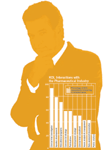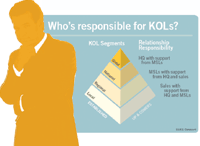Key Opinion Leaders Interactions with Pharma
Pharmaceutical Executive
Data suggest that pharma companies engage the same key opinion leaders on assignments in three to seven departments or product groups at once.
Pharmaceutical companies walk a dangerous line with key opinion leaders (KOLs). Over the past five or six years, a much wider range of departmental and product groups have engaged KOLs in an ever-broader range of assignments. Discovery researchers ask doctors to foresee unmet needs in their specialties a decade down the road, while marketers want to know how a drug should be positioned over the final years of its lifecycle to remain a clinically effective—and profitable—product. From clinical-trials consultant and expert speaker to advisory board member, pharma's appetite for medical specialists keeps growing.
However, the number of physicians available to play these roles cannot keep pace with demand. Inevitably, pharma turns to the same people again and again. At the same time, regulations—especially the guidelines released by OIG—threaten serious consequences for companies that seem to be offering quid pro quo compensation to their physician customers. To stay out of trouble, companies must learn who their KOLs are, how they fit the needs of different departments (siloed in larger companies), and how management can complete financial transactions within OIG guidelines.

KOL Interactions with the Pharmaceutical Industry
Some KOLs Are Everywhere
As the same KOLs pop up in many different roles within the same company, one department or brand may have no idea what the others are doing. The potential exists for a company to unwittingly pay one opinion leader so much money that the relationship attracts unfavorable attention. If an opinion leader makes, say, 20 percent of his or her annual salary in consulting fees from one company, that organization can expect bad press and regulatory scrutiny.
Of course, companies have a legitimate need for advice from doctors who use their products. And sometimes, companies can easily keep track of their consultants. A leading manufacturer of orthopedic fixation devices, for instance, routinely invites leading orthopedic surgeons to its internal operating room to use the devices and offer feedback. The company is not too large, and it can keep track of who visits.
But companies with far-flung affiliates and rigid product and departmental silos are not so lucky. In a single therapeutic group, all marketers of three different heart medications may approach the same cardiologist for advice. The KOL may also be asked for his or her input at the discovery or clinical-trial stage of other company products. Before anyone at the company notices—that is, in the absence of centralized oversight—the doctor is collecting fees from five or six departments. He knows how much money is coming in, but the company may not know how much is going out.
Affiliates in other countries may also invite the same physician from the United States to speak at conferences. The result: Fees that are disbursed from cost centers around the globe, without the least accountability to one another, appear to an outside observer like OIG to come from one centralized, multinational corporation.
Companies need to understand which KOLs are working for them, and in what capacities. A Clarescent survey of global KOLs suggests that most KOLs participate in three to seven programs at once with a single pharmaceutical company. Often, the KOL knows the extent of his or her roles with a pharma company better than the company understands its deployment of the KOL.
Who Are the KOLs?
Key opinion leaders can be divided into classes based on how established they are, and how far their influence reaches. Some KOLs are well known. Others are emerging stars. They can be divided into established KOLs and up-and-comers. These groups are interesting for different reasons, but must be managed in similar ways.
A more important distinction, especially for a large company where the departments are siloed, divides experts into global, national, regional, and local KOLs. Each is important to the company for different reasons, and must be managed by a different sector of the company. Global KOLs, who publish in the New England Journal of Medicine or JAMA and speak at international conferences, are easily identified and well-known throughout the company. Contact should be maintained at the highest level of management. Local leaders, who may not be known beyond neighboring county hospitals, help colleagues with tricky diagnoses and influence many treatment decisions. These physicians, who may not publish or participate in clinical trials, need to be identified and courted by local sales representatives with support from medical-science liaisons (MSLs).
Singling out the national and regional KOLs, especially the emerging stars, can be more difficult. Many, but not all, have a significant presence in the public domain. They have published; they serve as principal investigators on studies; or they are affiliated with hospitals or other large institutions that post a bio on their Web sites. In short, they leave an electronic trail.

Whoôs responsible for KOLs?
But showing up in Google is not enough. Companies must marshal other resources to reliably identify national, and especially regional, KOLs. First, they need to poll experts within their own organization, especially if it is very large. If a company is close to launching a product, it has already been working in the therapeutic area for at least ten years. People in early clinical development or discovery have probably identified people who were doing cutting-edge science in that area. Also, brand teams for other products in the same therapeutic area will know doctors. Other people in the company have been meeting doctors at conferences and congresses.
Other physicians who have done consulting work with the company may know some KOLs. Companies should ask the opinion leaders they already know. Most will be glad to offer objective feedback. Finally, there are third-party consultants that specialize in tools such as influence mapping. They survey doctors in a discipline, such as oncology, about whom they turn to for diagnostic help when a tough case comes along. Typically, such studies lead companies not just to the leading experts, but also to influential people known primarily to their peers. Contact with regional and local KOLs can be maintained by medical-science liaisons or other field-based roles.
Managing KOLs
If, as the Clarescent survey of global KOLs suggests, many physicians and scientists are working on a half-dozen projects within a single pharmaceutical company, it is not easy to know how high their total fees are. Paying an individual consultant too much over the course of a year can cause a public-relations nightmare or trigger an OIG investigation. How should a company create a transparent structure to track payments?
First, the company needs to create a centralized position or department that is responsible for owning and managing opinion-leader relationships—especially with a national or global KOL. Second, a central database should track every KOL who works for a company, and note who within the company has had contact with him or her. (Business rules should govern who has to log contacts with the KOL.) Each payment to the KOL should be entered in the centralized database, and a transparent rule should govern the annual payment caps for consultants.
Of course, centralizing payments is not as easy as it sounds. Many KOLs appear under different descriptions. Sometimes a company may pay the physician directly, which can be logged to a social security number. But other payments may go to an employee ID number, to a hospital clinic, to an academic department at a university, to a private company developing CME materials, or through another third party, such as a KOL agency supporting an advisory board. Each of these payments could benefit the same doctor. In the end, companies will have to change their cultures to follow the money. Even when the transactions are recorded between institutions, the deals are made by individuals. Team members will have to communicate—and document why they deal with particular consultants or institutions.
OIG Is Watching
OIG changed the regulatory environment by requiring companies to justify their intentions, as well as account for their payments to consultants (see "Crimes in the Closet"). To steer clear of an OIG investigation, companies must specify criteria for selecting and paying consultants. Federal regulators no longer accept, for instance, paying 30 doctors as "consultants" to listen to a conference call. If OIG argues that the doctors were paid to hear a pitch, there may be no defense. Firms do have a right to solicit input from customers and pay fair market value for it (see Medical Education Meetings, a Pharm Exec supplement, Sept. 2005). But whatever else it does, a company must document, in advance, why it hired a particular consultant, and why it paid the specific fee. In the process, a company may learn how much it pays its KOLs.
Kashif Chaudhry is a principal and Anne Love is a consultant at Clarescent LLC. They can be reached at kashif.chaudhry@clarescent.com and anne.love@clarescent.com respectively.

The Misinformation Maze: Navigating Public Health in the Digital Age
March 11th 2025Jennifer Butler, chief commercial officer of Pleio, discusses misinformation's threat to public health, where patients are turning for trustworthy health information, the industry's pivot to peer-to-patient strategies to educate patients, and more.
Navigating Distrust: Pharma in the Age of Social Media
February 18th 2025Ian Baer, Founder and CEO of Sooth, discusses how the growing distrust in social media will impact industry marketing strategies and the relationships between pharmaceutical companies and the patients they aim to serve. He also explains dark social, how to combat misinformation, closing the trust gap, and more.